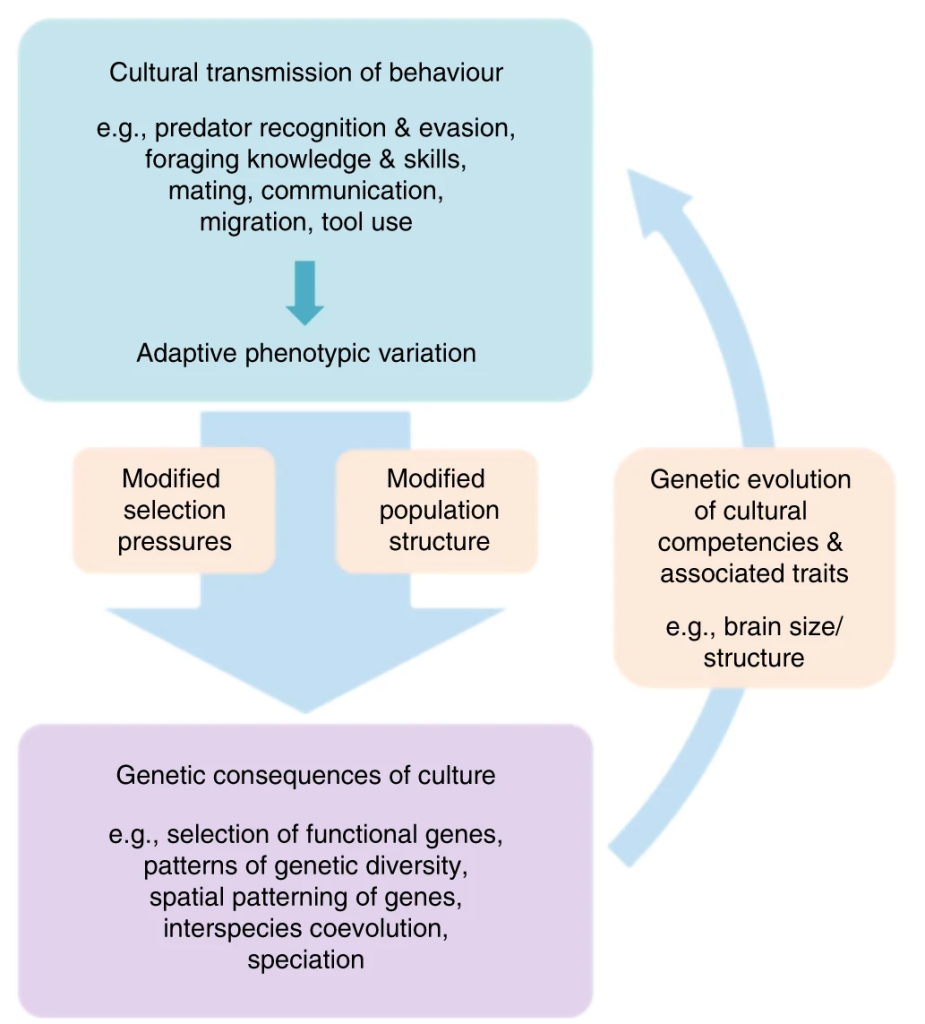7.4 Gene-Culture Coevolution
Recall that natural adaptation is a process that targets the phenotype, not the genotype. While the genotype certainly changes over time, and often in critical ways, it is the phenotype that responds to the selective pressures in an organism’s EEA.
How can this be?
Each trait is, in essence, made of two broad components. One is the genotype – the genetic code, the DNA, the tendency toward a specific trait. The other is the environment within which that genotype is or is not expressed. For example, it is possible to have a mutated allele in the BRCA1 or BRCA2 gene – commonly connected with how likely someone is to develop breast cancer. However, simply carrying the mutated allele for a trait does not always mean the trait will express. Proper nutrition, exercise, and other behavioral factors, like smoking or drinking, are known to contribute to or prevent cancer growth. In the case of breast cancer, excess sugars in the diet have long been connected with the increased rate of breast cancer in diabetic patients.
So, how do the genotype and environment combine to create the resulting phenotype? Enter an incredibly important, mathematical equation:
Genotype + Environment = Phenotype
This equation allows us to consider the variables that come together in the gene-environment interaction. Any given trait has a degree of flexibility to the environment. Traits that are inflexible and likely to be the same, regardless of environmental influence, are said to be canalized – that is, they are predictable. An example is eye color. A person cannot simply eat different food or live in a warmer climate and change their eye color. The trait is stable, predictable, canalized.
Alternatively, if a trait is plastic, it is incredibly responsive to the environment and may result in a variety of phenotypes. An animal’s weight, height, and even talent for certain skills are all highly variable skills that respond to environmental input. For example, humans are, by and large, born with a sense of rhythm and attraction to melodies. However, whether a person develops this attraction into playing a musical instrument or singing is responsive to the presence of mentors and opportunities to develop the skill. In the case of behavioral traits, like playing piano, we refer to behavioral plasticity – or the ability to learn.
Now, back to our mathematical equation. If a trait is canalized, the variable genotype will be a higher number. Likely, significantly higher than environment. The equation for a canalized trait might look like this:
(G) 95% + (E) 5% = (Pc) a canalized trait/phenotype
However, if a trait is plastic and develops based upon the environment of the moment, the equation will look more like this:
(G) 5% + (E) 95% = (Pp) a plastic trait/phenotype
Of course, life is rarely that clear and simple. If we return to the genetic tendency of someone with a mutated BRCA1 or BRCA2 gene to develop breast cancer, the equation may look more like this:
(G) 42% + (E) 58% = (P)
(e.g., likelihood of developing breast cancer)
Note: This is an example, and in no way is meant to indicate the exact probability of developing breast cancer.
The interactions between genotype and the environment, can result in phenotypes that undergo positive selection. For example, in early humans, increasingly sophisticated tools and hunting led to more successful foraging and higher caloric quality. As a result, our brains began to expand. Then cooperation helped us increase group size and safety against predators. Our brains grew again. This is an example of gene-culture coevolution. The genotypes that are more common within successful phenotypes are, themselves, reproduced with more frequency in a population.

Traits that show low levels of variation; less responsive to environmental change.
the ability of an individual genotype to produce different phenotypes in response to the environment.
a change in an organism's behavior that results from exposure to stimuli, such as changing environmental conditions.

